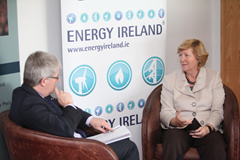Meeting Europe’s 2020 targets
 Marie Donnelly, Renewable Energy Director for the European Commission, discusses energy efficiency and innovation with Owen McQuade.
Marie Donnelly, Renewable Energy Director for the European Commission, discusses energy efficiency and innovation with Owen McQuade.
Europe is on track to meet, and possibly exceed, two of its three 2020 energy targets. However, more work must be done in order to become more energy efficient. Member states must collectively reduce greenhouse gases by 20 per cent, increase their share of renewables by 20 per cent and reduce energy consumption by 20 per cent from their 1990 baseline levels.
Marie Donnelly contends that while the greenhouse gas target is on track and the renewable target could be exceeded by 0.6 per cent, the energy efficiency projections only reach 10 per cent.
“As a consequence, this is where our policy efforts are focused at the moment,” Donnelly states.
She refers to the Energy Efficiency Plan, released in March, which encourages a stronger emphasis on energy efficiency in the public sector through public purchasing, the refurbishment of public buildings and the encouragement of high performance in cities and communities. The strategy also calls for better energy training in the construction sector; consideration of district heating in urban plans; and the establishment of energy service companies. These companies would deliver energy efficiency improvements, accept financial risk by covering – or helping to finance – upfront investment costs be financed through the savings achieved.
Energy efficiency
In addition, the Commission released its proposed Energy Efficiency Directive in June. According to Donnelly, the directive encompasses “one of our biggest problems; buildings.” She explains that Europe uses 40 per cent of its energy for heating and cooling. “If we can secure the envelope of our buildings we can dramatically reduce that demand,” she contends. However, “part of the difficulty is [that] we are an established economy; our buildings are there.”
Member states construct 1 per cent new buildings every year and retrofit 1.5 per cent. “That rate of retrofit is not sufficiently fast,” Donnelly states.
The directive calls for the public sector to lead by example “by retro-fitting at least 3 per cent of their square meterage every year to the highest level [in order] to show people what it will look like when it’s done.”
Also, energy suppliers will face an energy efficiency obligation “to save 1.5 per cent of energy each year cumulatively going forward.”
Donnelly points out that this scheme is operational in the UK, France, Italy and Denmark and “is proving rather successful.” She explains that it operates by energy suppliers “grant-aiding, supporting or even paying directly for cavity wall insulation, double-glaze, new boilers [and] efficiency systems in their consumers’ homes.”
Donnelly believes that “it’s a very consumer-friendly approach” but acknowledges that “it’s a challenge for the utilities to deliver.”
When people think of renewables they tend to focus on electricity and wind. Donnelly believes that heating and cooling and biomass are also important.
Because heating and cooling represents 40 per cent of our energy, it is “a key area to address going forward.” In order to ensure that Europe meets both the energy efficiency and renewable targets, reducing demand for heating and cooling is essential, Donnelly emphasises.
She points out that “many renewable energies can deliver cost-effective heating and cooling, for example, a solar thermal panel in the roof to heat water.”
The Commission is currently “looking at biomass contributing half of the renewable targets in Europe.”
Biomass currently contributes 80 per cent to the heating and cooling from renewable sources. This leads to concerns about land management. Donnelly states that lowering this demand is “key” because “the ultimate demand on our land will be huge if we continue on this basis.” Europe’s sustainability criteria are “the strictest in the world” because of concerns about land, therefore Donnelly suggests: “If you are going to have onshore wind farms, would it be possible to have very tall wind turbines that stand over the forest so that you are getting double usage of the land?”
 Another idea, she contends, would be to place solar panels on ‘a leg’ so that they turn to the sun allowing light to come down and creating the possibility of growing biomass underneath.
Another idea, she contends, would be to place solar panels on ‘a leg’ so that they turn to the sun allowing light to come down and creating the possibility of growing biomass underneath.
“We are looking at a number of culminations like that; maximising the use of land so that we ensure we don’t jeopardise the supply of food and ultimately the living space that we need.”
In terms of energy infrastructure “there are some mechanical approaches that can be taken at national, regional and local level,” Donnelly says.
The first is workflow. She elaborates: “How many different authorities are involved? Do they all have a timeline and, if so, is it sequential or can all the mechanisms operate in parallel?”
Some member states have a system whereby there may be four to six authorities involved in the process, but only one will “give an answer.” Donnelly explains that “if there is an appeal, it is just against that single answer, as opposed to the individual six.”
She sums up: “This is a relatively mechanical approach to administrative streamlining which doesn’t endanger the legitimate right of citizens and consumers to have a say, doesn’t undermine the responsibility of authorities to do their jobs, but just applies a workflow approach to be as efficient as possible.”
Energy will continue to be a priority for the European Commission going forward, as shown by its commitment to increase funds spent on climate action by 20 per cent in its recent budgetary proposals for
2014-2020. Priorities for funding include renovation of buildings, smart grids, renewable energies and innovation in transport.
Donnelly adds: “Over the period of this financial prospectus [seven years], investment in energy has gone up each year. We hope that upward projection will continue and we do expect, from our discussions with member states, that they will support that general approach.”
Looking towards 2050, Donnelly stresses that energy efficiency will be the “first, second, third, middle and last” priority.
“If we could get our energy efficiency right, it would put us in an entirely different scenario,” she claims.
The second area to concentrate on is transport, she concludes.
“The reality is that we need transport, but the question is: ‘Do we need transport in the form we currently have and are there alternatives we can achieve?’”





